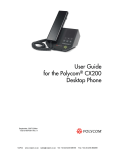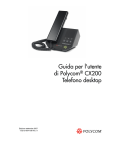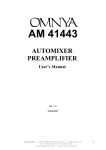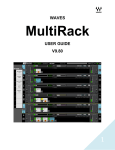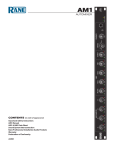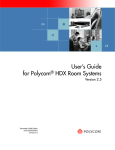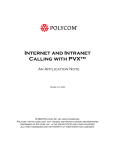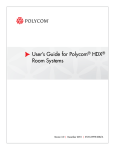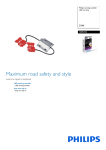Download Echo Troubleshooting Guide - Support
Transcript
Echo Troubleshooting Guide How to identify, troubleshoot and remove echoes in installed-room AV systems Application Note Polycom Installed Voice Business Group September 2004 TABLE OF CONTENTS TABLE OF CONTENTS ....................................................................................... 2 INTRODUCTION .................................................................................................. 3 TYPES OF ECHO................................................................................................. 3 Acoustic Echo............................................................................................................................3 Line Echo...................................................................................................................................5 Loopback Echo..........................................................................................................................6 Room Echo................................................................................................................................7 LOCAL SITE HEARS ECHO................................................................................ 8 Remote Site Connects Via Handset..........................................................................................8 Remote Site Connects Via Telephone Hybrid.........................................................................10 Remote Location Connects Via Video Codec .........................................................................11 Remote Location Connects Via Telephone Bridge .................................................................12 Remote Site Connects Via Video Bridge ................................................................................13 REMOTE SITE HEARS ECHO........................................................................... 14 Remote Site Connects Via Handset........................................................................................14 Remote Site Connects Via Telephone Hybrid.........................................................................15 Remote Site Connects Via Video Codec ................................................................................16 Remote Site Connects Via Telephone Bridge.........................................................................18 Remote Site Connects Via Video Bridge ................................................................................19 TECHNICAL SUPPORT..................................................................................... 21 Polycom IVB Contact Information ...........................................................................................21 2 INTRODUCTION This is a guide to help you track down various types of echo that may appear during or after an installation of Vortex devices. Troubleshooting echo can be frustrating at times because the echo may only appear with certain devices, or what someone calls echo may not really be echo at all. Also, many people mistake the proper function of an acoustic echo canceller or believe that the line echo canceller can also be used as an acoustic echo canceller. In this guide, we refer to local rooms and remote rooms. A local room is the room that has the acoustic echo canceller and/or line echo canceller installed. Local rooms are always called "Room A". The remote room may or may not have that equipment installed in it. Remote rooms are called "Room B". TYPES OF ECHO There are 4 main types of echo that you will encounter: ACOUSTIC ECHO This is caused when a remote location calls into a local room via a handset, telephone hybrid, video codec, or other communications device. The echo is generated when there is an acoustic coupling between the local room's loudspeakers and microphones. Only the person in the remote location will hear this echo. The characteristic of an acoustic echo is that there will be a noticeable delay of the echo that the remote location will hear. Also, the echo of the remote speech will not be a very good copy of the original speech since the original speech is convolved with the room response and then acoustically coupled into the local room's microphones. 3 Here is a diagram of telephone acoustic echo: Here is a diagram of video codec acoustic echo: 4 LINE ECHO This is caused only when a telephone hybrid is used. When you make a phone call, the central office intentionally generates sidetone so that you, the caller, know that you are still connected to the other party of the call. From a technical perspective, the sidetone is caused by an impedance mismatch of the 2-wire to 4-wire transformer at the central office. When you use a telephone hybrid to make a phone call, you typically listen to the audio via loudspeakers in the local room. Under these circumstances, the sidetone becomes very noticeable and very distracting and can occasionally result in howling/squealing in the local sound system. Only the local room will hear this echo. The characteristic of line echo is that there is very little delay (< 30 milliseconds) and the echo should sound like a good copy of your original audio that has been bandlimited to 3.5 kHz (the bandwidth of a typical telephone call). Here is a diagram of Telephone Line Echo: 5 LOOPBACK ECHO This is echo that is electronically generated. Loopback echo is typically caused by an incorrect matrix assignment that causes speech to be sent back to its origination point. For example, let's say that the incoming remote audio is present on Input A. All audio to be sent to the remote end is placed on Output A. If Input A is assigned to Output A via the matrix mixer, a loopback echo has been created. Only the person on the far end will hear this echo. The characteristic of this echo is that the echo will be a very good copy of the original audio depending on the method of transmission (telephone or video codec). If the remote location is using a telephone hybrid, there will be less delay than associated with an acoustic echo. If the remote location is using a video codec, there will be no change in the delay versus an acoustic echo. Here is a diagram of telephone loopback echo, showing how a remote audio mixer can return the local talker’s audio: 6 Here is a diagram of video codec loopback echo. The only difference is in the transmission method: ROOM ECHO (REVERBERATION) In a very acoustically live room, the local participants may hear a copy of their own speech. This copy is caused by the hard surfaces of the room. The surfaces reflect a majority of the sound waves that are placed upon them and that in turn adds a "reverb" effect to all sound in the room. Technically, this is not echo but many people refer to this as echo. Depending upon the placement and types of microphones used, the remote side may hear this echo because the local microphones cannot distinguish between the original speech and the reflected speech from the room. To solve this, make sure that the microphone audio that is sent to the far end is automatically mixed in the Vortex (in 7 Conference Composer, use the AUTOMIXER and MATRIX MIXER pages). If that doesn't solve the problem, you may want to put acoustic treatment in the room. This will help deaden the room. Here is a diagram of room echo: LOCAL SITE HEARS ECHO REMOTE SITE CONNECTS VIA HANDSET 8 For this example, we have a remote site that calls the local site via a handset; thus, there is no possibility of an acoustic echo from the remote site. The local room will be referred to as Room A and the remote site will be referred to a Room B. 1. Define the echo. Is there noticeable delay on the echo? If so, the echo may not be caused by the equipment in Room A. 2. Double-check your connections to the telephone hybrid or your matrix assignments depending on the hybrid type. 3. Make sure that you are sending good levels to the telephone hybrid. Low levels may cause the Line Echo Canceller to delay converging to the telephone line. 4. Check to make sure that the Line Echo Canceller is enabled in the OPTIONS page of the hybrid. 5. If possible, have Room B mute their handset. 6. Disable any sound reinforcement in Room A. 7. Mute Room A's microphones. Does the echo persist? If not, there is a problem in the matrix mixer that is causing Room A's microphones to be sent to Room A's loudspeakers. 8. If you are still hearing echo, terminate the call. Is the echo still there? If not, there is a problem in the matrix mixer that is Room A's microphones to be sent to Room A's loudspeakers. 9. Unmute Room A's microphones and re-connect the phone call to Room B. Is the echo still there. If it is, is the echo consistent or do you hear short bursts of echo? Short bursts may indicate that the line conditions are not consistent enough for the Line Echo Canceller to completely converge to the phone line. As the conditions change, the Line Echo Canceller reconverges to the line and during that process, you may hear echo. If you are using an analog phone line from a central office, have the line checked and request that the technician make measurements using a time-domain reflectometer (TDR). This device looks for faults in the signal path between the central office and your location. If you are using a analog simulation card in a PBX, make sure the card is setup properly. Replace the card and see if the problem persists. Consistent echo may indicate that there is a lot of noise on the telephone line. Disable the noise cancellation in the hybrid to get a true measurement of the line noise. Have the line checked to make sure it meets the noise specifications. 9 REMOTE SITE CONNECTS VIA TELEPHONE HYBRID For this example, we have a remote site that calls the local site via a telephone hybrid. The local room will be referred to as Room A and the remote site will be referred to a Room B. 1. Define the echo. Is there noticeable delay on the echo? If so, the echo may be caused by the acoustic echo canceller in the remote location's room. 2. Double-check your connections to the telephone hybrid or your matrix assignments depending on the hybrid type. 3. Make sure that you are sending good levels to the telephone hybrid. Low levels may cause the Line Echo Canceller to delay converging to the telephone line. 4. Check to make sure that the Line Echo Canceller is enabled in the OPTIONS page of the hybrid. 5. Disable any sound reinforcement in Room A. 6. Mute Room A's microphones. Does the echo persist? If not, there is a problem in the matrix mixer that is causing Room A's microphones to be sent to Room A's loudspeakers. 7. Unmute the microphones in Room A. Have Room B mute their microphones. Is the echo still there? If not, Room B's acoustic echo canceller is not cancelling the local room's echo properly (Remember that the echo canceller in the local room is always for the benefit of the remote location). 8. If you are still hearing echo, terminate the call. Is the echo still there? If not, there is a problem in the matrix mixer that is causing Room A's microphones to be sent to Room A's loudspeakers. 9. Re-connect the phone call to Room B and see if the echo is still there. If it is, is the echo consistent or do you hear short bursts of echo? Short bursts may indicate that the line conditions are not consistent enough for the Line Echo Canceller to completely converge to the phone line. As the conditions change, the Line Echo Canceller re-converged to the line and 10 during that process, you may hear echo. If you are using an analog phone line from a central office, have the line checked and request that the technician make measurements using a time-domain reflectometer (TDR). This device looks for faults in the signal path between the central office and your location. If you are using a analog simulation card in a PBX, make sure the card is setup properly. Replace the card and see if the problem persists. Consistent echo may indicate that there is a lot of noise on the telephone line. Disable the noise cancellation in the telephone hybrid to get a true measurement of the line noise. Have the line checked to make sure it meets the minimum noise specifications set forth by the local provider. REMOTE LOCATION CONNECTS VIA VIDEO CODEC For this example, we have a remote site that calls the local site via a video codec. The local room will be referred to as Room A and the remote site will be referred to a Room B. 1. Define the echo. Is there noticeable delay on the echo? If so, the echo may be caused by the acoustic echo canceller in the remote location's room. 2. Double-check your connections to the video codec and your matrix assignments. With some video codecs, you need to use a specific set of inputs and outputs; otherwise, a loopback will be created inside the codec. Click here for more information. 3. Make sure that you are sending good levels to the video codec. 4. Disable any sound reinforcement in Room A. 5. Mute Room A's microphones. Does the echo persist? If not, there is a problem in the matrix mixer that is causing Room A's microphones to be sent to Room A's loudspeakers. 6. Unmute Room A's microphones and have Room B mute their microphones. Is the echo still there? If not, Room B's acoustic echo canceller is not cancelling Room A's echo properly (Remember that the echo canceller in the local room is always for the benefit of the remote location). 7. If you are still hearing echo, terminate the call. Is the echo still there? If not, there is a problem in the matrix mixer that is causing Room A's 11 microphones to be sent to Room A's loudspeakers. REMOTE LOCATION CONNECTS VIA TELEPHONE BRIDGE For this example, we have a local room that calls into a telephone bridge. The local room will be referred to as Room A. Other sites also call into this telephone bridge. One of the remote sites complains of echo. This site will be referred to as Room B. 1. Define the echo. Is there noticeable delay on the echo? If so, the echo may be caused by the acoustic echo canceller in the remote location's rooms. 2. Double-check your connections to the telephone hybrid or your matrix assignments depending on the hybrid type. 3. Make sure that you are sending good levels to the telephone hybrid. Low levels may cause the Line Echo Canceller to delay converging to the telephone line. 4. Check to make sure that the Line Echo Canceller is enabled in the OPTIONS page of the hybrid. 5. Disable any sound reinforcement in Room A. 6. Mute Room A's microphones. Does the echo persist? If not, there is a problem in the matrix mixer that is causing Room A's microphones to be sent to Room A's loudspeakers. 7. Unmute Room A's microphones and have each remote location mute their microphones. Is the echo still there? If not, one of the remote location's 12 acoustic echo cancellers is not cancelling the local room's echo properly (Remember that the echo canceller in the local room is always for the benefit of the remote location). By muting each room one at a time, you can easily find out which site is the cause of the problem. 8. If you are still hearing echo, terminate the call. Is the echo still there? If not, there is a problem in the matrix mixer that is causing Room A's microphones to be sent to Room A's loudspeakers. 9. Re-connect the phone call to the telephone bridge and see if the echo is still there. If it is, is the echo consistent or do you hear short bursts of echo? Short bursts may indicate that the line conditions are not consistent enough for the Line Echo Canceller to completely converge to the phone line. As the conditions change, the Line Echo Canceller re-converged to the line and during that process, you may hear echo. If you are using an analog phone line from a central office, have the line checked and request that the technician make measurements using a time-domain reflectometer (TDR). This device looks for faults in the signal path between the central office and your location. If you are using a analog simulation card in a PBX, make sure the card is setup properly. Replace the card and see if the problem persists. Consistent echo may indicate that there is a lot of noise on the telephone line. Disable the noise cancellation to get a true measurement of the line noise. Have the line checked to make sure it meets the noise specifications. 10. Some telephone bridges have problems generating the appropriate audio mixes when they are processing many simultaneous calls at once. These problems usually only occur when the number of simultaneous calls starts to meet the maximum number of calls the bridge can process. Try having some sites disconnect and see if the echo gets better. REMOTE SITE CONNECTS VIA VIDEO BRIDGE For this example, we have a local room that calls into a video bridge. The local room will be referred to as Room A. Other sites also call into this video bridge. One of the remote sites complains of echo. This site will be referred to as Room B. 1. Define the echo. Is there noticeable delay on the echo? If so, the echo may be caused by the acoustic echo canceller in one or more of the remote location's rooms. 2. Double-check your connections to the video codec and your matrix assignments. With some video codecs, you need to use a specific set of inputs and outputs; otherwise, a loopback will be created inside the codec. Click here for more information. 3. Make sure that you are sending good levels to the video codec. 13 4. Disable any sound reinforcement in Room A. 5. Mute Room A's microphones. Does the echo persist? If not, there is a problem in the matrix mixer that is causing Room A's microphones to be sent to Room A's loudspeakers. 6. Unmute Room A's microphones and have Room B mute their microphones. Is the echo still there? If not, one of the remote location's acoustic echo cancellers is not cancelling Room A's echo properly (Remember that the echo canceller in the local room is always for the benefit of the remote location). By muting each room one at a time, you can easily find out which site is the cause of the problem. 7. If you are still hearing echo, terminate the call. Is the echo still there? If not, there is a problem in the matrix mixer that is causing Room A's microphones to be sent to Room A's loudspeakers. 8. Some older video bridges did not perform an internal mix-minus so that whatever signal that was sent to the video bridge from the local room was sent back to the local room as well as a mix of all other remote sites. This would certainly cause an echo to be created for Room A. Have the setup of the video bridge checked to see if this feature can be disabled. REMOTE SITE HEARS ECHO REMOTE SITE CONNECTS VIA HANDSET For this example, we have a remote site that calls the local site via a handset; thus, there is no possibility of an acoustic echo from the remote site. The local room will be referred to as Room A and the remote site will be referred to a Room B. 1. Have Room B define the echo. Is there noticeable delay on the echo? If so, the echo may be caused by the acoustic echo canceller in tRoom A. 2. If Room B says that they hear echo of Room A's speech, this is most likely Room Echo. Make sure the automixer is enabled on all microphone 14 channels and that the each cross-point in the matrix mixer is set to gated for all microphones that are routed to the telephone hybrid. Also, try to move closer to the microphone to see if the problem goes away. If the remote location still complains of Room Echo, you may need to acoustically treat the local room. 3. Mute Room A's microphones. If the echo goes away, the echo is caused by telephone network conditions. Disconnect and call Room B back. If the echo is still there, Room B needs to have their line tested. 4. Mute the output to the Room A's telephone hybrid. If the echo goes away, you have created a Loop Back echo in the matrix mixer. 5. Unmute both the microphones and the output to the telephone hybrid in Room A. Check to make sure that the acoustic echo canceller is enabled and that the reference is defined properly. 6. Check your microphone input levels. You should be consistently lighting up the first yellow LED on the MIC/LINE INPUTS page or on the Input Meter on the front of the unit. 7. Go to the DIAGNOSTICS page. Have Room B talk. At the same time, look at the room gain meter for Room A. Is the room gain very high (>10)? Lower the loudspeaker volume. Does the echo go away? If so, try to increase the distance from the microphone from the loudspeaker, or go to Step 9. 8. Is there a lot of ambient noise in the room? Go to Step 9. 9. Go to the MIC/LINE INPUTS page. Change the Suppression mode for the acoustic echo canceller to YIKES! mode. If the echo goes away, change the Suppression to HEAVY mode. Does the echo go away? If so, the acoustical room conditions may not fully allow full-duplex audio with no acoustic echo. A lot of room gain or high ambient noise may cause the echo canceller to have problems converging to the remote parties signal. By changing the Suppression to HEAVY or YIKES! mode, you start to move toward a half-duplex system, but you should be able to remove the echo. 10. If there is still echo in HEAVY or YIKES! mode, enable the REFERENCE Bias option in the Automixer if you have firmware version 2.1.0 or higher. The Reference Bias uses the reference signal for the acoustic echo canceller as an input to the automixer. Initially, set the Bias equal to the room gain value. REMOTE SITE CONNECTS VIA TELEPHONE HYBRID For this example, we have a remote site that calls the local site via a telephone hybrid. The local room will be referred to as Room A and the remote site will be referred to a Room B. 15 1. Have Room B define the echo. Is there noticeable delay on the echo? If so, the echo may be caused by the acoustic echo canceller in tRoom A. 2. If Room B says that they hear echo of Room A's speech, this is most likely Room Echo. Make sure the automixer is enabled on all microphone channels and that the each cross-point in the matrix mixer is set to gated for all microphones that are routed to the telephone hybrid. Also, try to move closer to the microphone to see if the problem goes away. If the remote location still complains of Room Echo, you may need to acoustically treat the local room. 3. Mute Room A's microphones. If the echo goes away, the echo is caused by the telephone hybrid in Room B. Have Room B call into Room A via a handset to verify that the hybrid is the source of the problem. If Room B still hears echo, Room B needs to have their line checked. 4. Mute the output to the Room A's telephone hybrid. If the echo goes away, you have created a Loop Back echo in the matrix mixer. 5. Unmute both the microphones and the output to the telephone hybrid in Room A. Check to make sure that the acoustic echo canceller is enabled and that the reference is defined properly. 6. Check your microphone input levels. You should be consistently lighting up the first yellow LED on the MIC/LINE INPUTS page or on the Input Meter on the front of the unit. 7. Go to the DIAGNOSTICS page. Have Room B talk. At the same time, look at the room gain meter for Room A. Is the room gain very high (>10)? Lower the loudspeaker volume. Does the echo go away? If so, try to increase the distance from the microphone from the loudspeaker, or go to Step 9. 8. Is there a lot of ambient noise in the room? Go to Step 9. 9. Go to the MIC/LINE INPUTS page. Change the Suppression mode for the acoustic echo canceller to YIKES! mode. If the echo goes away, change the Suppression to HEAVY mode. Does the echo go away? If so, the acoustical room conditions may not fully allow full-duplex audio with no acoustic echo. A lot of room gain or high ambient noise may cause the echo canceller to have problems converging to the remote parties signal. By changing the Suppression to HEAVY or YIKES! mode, you start to move toward a half-duplex system, but you should be able to remove the echo. 10. If there is still echo in HEAVY or YIKES! mode, enable the REFERENCE Bias option in the Automixer if you have firmware version 2.1.0 or higher. The Reference Bias uses the reference signal for the acoustic echo canceller as an input to the automixer. Initially, set the Bias equal to the room gain value. REMOTE SITE CONNECTS VIA VIDEO CODEC 16 For this example, we have a remote site that calls the local site via a video codec. The local room will be referred to as Room A and the remote site will be referred to a Room B. 1. Have Room B define the echo. Is there noticeable delay on the echo? If so, the echo may be caused by the acoustic echo canceller in Room A. 2. If Room B says that they hear echo of Room A's speech, this is most likely Room Echo. Make sure the automixer is enabled on all microphone channels and that the each cross-point in the matrix mixer is set to gated for all microphones that are routed to the video codec. Also, try to move closer to the microphone to see if the problem goes away. If the remote location still complains of Room Echo, you may need to acoustically treat the local room. 3. Mute Room A's microphones. If the echo goes away, the echo is caused by improper setup of the video codec in Room B. 4. Mute the output to Room A's video codec. If the echo goes away, you have created a Loop Back echo in the matrix mixer. 5. Make sure that the acoustic echo canceller in Room A's video codec can be disabled. If it can't, the echo canceller in the codec may be attempting to cancel the echo that it thinks is present on the inputs. Unfortunately, this may actually add echo since the codec's echo canceller is trying to subtract the inverse signal of the echo from a signal that has already been echo cancelled. Mute the output of the video codec. If the echo goes away, double-check the settings for the internal acoustic echo canceller. This information is located in the Interfacing to Video Codecs section of the Application Notes folder of the help file. 6. Also, some video codecs must use a specific input/output combination so that audio is not looped back onto itself. Click here for more information. 7. Unmute both the microphones and the output to the video codec in Room A. Check to make sure that the acoustic echo canceller is enabled and that the reference is defined properly. 8. Check your microphone input levels. You should be consistently lighting up the first yellow LED on the MIC/LINE INPUTS page or on the Input Meter on the front of the unit. 9. Go to the DIAGNOSTICS page. Have Room B talk. At the same time, look at the room gain meter for Room A. Is the room gain very high (>10)? Lower the loudspeaker volume. Does the echo go away? If so, try to increase the distance from the microphone from the loudspeaker, or go to Step 11. 10. Is there a lot of ambient noise in the room? Go to Step 11. 11. Go to the MIC/LINE INPUTS page. Change the Suppression mode for the acoustic echo canceller to YIKES! mode. If the echo goes away, change the Suppression to HEAVY mode. Does the echo go away? If so, the 17 acoustical room conditions may not fully allow full-duplex audio with no acoustic echo. A lot of room gain or high ambient noise may cause the echo canceller to have problems converging to the remote parties signal. By changing the Suppression to HEAVY or YIKES! mode, you start to move toward a half-duplex system, but you should be able to remove the echo. 12. If there is still echo in HEAVY or YIKES! mode, enable the REFERENCE Bias option in the Automixer if you have firmware version 2.1.0 or higher. The Reference Bias uses the reference signal for the acoustic echo canceller as an input to the automixer. Initially, set the Bias equal to the room gain value. REMOTE SITE CONNECTS VIA TELEPHONE BRIDGE For this example, we have a local room that calls into a telephone bridge. The local room will be referred to as Room A. Other sites also call into this telephone bridge. One of the remote sites complains of echo. This site will be referred to as Room B. 1. Have Room B define the echo. Is there noticeable delay on the echo? If so, the echo may be caused by the acoustic echo canceller in the local room. 2. If Room B says that they hear echo of Room A's speech, this is most likely Room Echo. Make sure the automixer is enabled on all microphone channels and that the each cross-point in the matrix mixer is set to gated for all microphones that are routed to the telephone hybrid. Also, try to move closer to the microphone to see if the problem goes away. If the remote location still complains of Room Echo, you may need to acoustically treat the local room. 3. Mute Room A's microphones. If the echo goes away, the echo is generated from Room A. Go to Step 5. 4. Have each remote site mute their microphones. Is the echo still there? If it is, the problem is with the telephone hybrid at Room B. If the echo is gone, one of the remote location's acoustic echo cancellers is not cancelling Room B's echo properly. By muting each room one at a time, you can easily find out which site is the cause of the problem. (Some telephone bridges have problems generating the appropriate audio mixes when they are processing many simultaneous calls at once. These problems usually only occur when the number of simultaneous calls starts to meet the maximum number of calls the bridge can process. Try having some sites disconnect and see if the echo gets better). 5. Mute the output to Room A's telephone hybrid. If the echo goes away, 18 you have created a Loop Back echo in the matrix mixer. 6. Unmute both the microphones and output to the telephone hybrid in Room A. Check to make sure that the acoustic echo canceller is enabled and that the reference is defined properly. 7. Check your microphone input levels. You should be consistently lighting up the first yellow LED on the MIC/LINE INPUTS page or on the Input Meter on the front of the unit. 8. Go to the DIAGNOSTICS page. Have Room B talk. At the same time, look at the room gain meter for Room A. Is the room gain very high (>10)? Lower the loudspeaker volume. Does the echo go away? If so, try to increase the distance from the microphone from the loudspeaker, or go to Step 10. 9. Is there a lot of ambient noise in the room? Go to Step 10. 10. Go to the MIC/LINE INPUTS page. Change the Suppression mode for the acoustic echo canceller to YIKES! mode. If the echo goes away, change the Suppression to HEAVY mode. Does the echo go away? If so, the acoustical room conditions may not fully allow full-duplex audio with no acoustic echo. A lot of room gain or high ambient noise may cause the echo canceller to have problems converging to the remote parties signal. By changing the Suppression to HEAVY or YIKES! mode, you start to move toward a half-duplex system, but you should be able to remove the echo. 11. If there is still echo in HEAVY or YIKES! mode, enable the REFERENCE Bias option in the Automixer if you have firmware version 2.1.0 or higher. The Reference Bias uses the reference signal for the acoustic echo canceller as an input to the automixer. Initially, set the Bias equal to the room gain value. REMOTE SITE CONNECTS VIA VIDEO BRIDGE For this example, we have a local room that calls into a video bridge. The local room will be referred to as Room A. Other sites also call into this video bridge. One of the remote sites complains of echo. This site will be referred to as Room B. 1. Have Room B define the echo. Is there noticeable delay on the echo? If so, the echo may be caused by the acoustic echo canceller in Room Athe local room. 2. If Room B says that they hear echo of the Room A's speech, this is most likely Room Echo. Make sure the automixer is enabled on all microphone 19 channels and that the each cross-point in the matrix mixer is set to gated for all microphones that are routed to the video codec. Also, try to move closer to the microphone to see if the problem goes away. If Room B still complains of Room Echo, you may need to acoustically treat Room A. 3. Mute Room A's microphones. If the echo goes away, the echo is generated from Room A. Go to Step 5. 4. Have each remote site mute their microphones. Is the echo still there? If it is, the problem is with the setup of the video codec in Room B. If the echo is gone, one of the other remote sites' acoustic echo cancellers is not cancelling Room B's echo properly. By muting each room one at a time, you can easily find out which site is the cause of the problem. (Some older video bridges did not perform an internal mix-minus so that whatever signal that was sent to the video bridge from the local room was sent back to the local room as well as a mix of all other remote sites. This would certainly cause an echo to be created for Room B. Have the setup of the video bridge checked to see if this feature can be disabled.). 5. If the echo is still there, mute the output to Room A's video codec. If the echo goes away, you have created a Loop Back echo in the matrix mixer. 6. Make sure that the acoustic echo canceller in Room A's video codec can be disabled. If it can't, the echo canceller in the codec may be attempting to cancel the echo that it thinks is present on the inputs. Unfortunately, this may actually add echo since the codec's echo canceller is trying to subtract the inverse signal of the echo from a signal that has already been echo cancelled. Mute the output of the video codec. If the echo goes away, double-check the settings for the internal acoustic echo canceller. This information is located in the Interfacing to Video Codecs section of the Application Notes folder of the help file. 7. Also, some video codecs must use a specific input/output combination so that audio is not looped back onto itself. Click here for more information. 8. Unmute both the microphones and the output to the video codec in Room A. Check to make sure that the acoustic echo canceller is enabled and that the reference is defined properly. 9. Check your microphone input levels. You should be consistently lighting up the first yellow LED on the MIC/LINE INPUTS page or on the Input Meter on the front of the unit. 10. Go to the DIAGNOSTICS page. Have Room B talk. At the same time, look at the room gain meter for Room A. Is the room gain very high (>10)? Lower the loudspeaker volume. Does the echo go away? If so, try to increase the distance from the microphone from the loudspeaker, or go to Step 12. 11. Is there a lot of ambient noise in the room? Go to Step 12. 12. Go to the MIC/LINE INPUTS page. Change the Suppression mode for the acoustic echo canceller to YIKES! mode. If the echo goes away, change the Suppression to HEAVY mode. Does the echo go away? If so, the 20 acoustical room conditions may not fully allow full-duplex audio with no acoustic echo. A lot of room gain or high ambient noise may cause the echo canceller to have problems converging to the remote parties signal. By changing the Suppression to HEAVY or YIKES! mode, you start to move toward a half-duplex system, but you should be able to remove the echo. 13. If there is still echo in HEAVY or YIKES! mode, enable the REFERENCE Bias option in the Automixer if you have firmware version 2.1.0 or higher. The Reference Bias uses the reference signal for the acoustic echo canceller as an input to the automixer. Initially, set the Bias equal to the room gain value. TECHNICAL SUPPORT For support on the Vortex product line, call toll-free (USA/Canada) 888-2484143, then select option 1, then option 3. For exclusive Integrator and Consultant focused support (through our PASS program), dial 1.408.474.2048; this number will get you help on video and Vortex products. For general technical support, dial 1.800.POLYCOM POLYCOM INSTALLED VOICE BUSINESS GROUP CONTACT INFORMATION Our address is: 9040 Roswell Road Suite 450 Atlanta, GA 30350 770-350-4140 Phone 770-350-4142 Fax Copyright © 2004 Polycom, Inc. 21 Polycom, the Polycom logo, Vortex, VS4000, and ViewStation are registered trademarks and iPower and VSX are trademarks of Polycom, Inc. in the USA and various countries. All other brand names, product names, and trademarks are the sole property of their respective owners 22






















